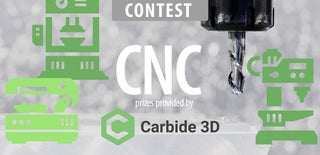Introduction: Animated Star Wars CNC LED Lamp Arduino Controlled
I'm really excited because this is my first ever Instructable! Before I get started I just want you to know that I am solely using the dictation option on an iPhone in the Instructables app. (So don't criticize me for my punctuation and grammar) :)
Secondly I want you to be encouraged that even if you're a novice you can do something like this or better!
Just a year and a half ago I had no experience or understanding of electronics. It was through reading other peoples indestructible's that I gained the understanding and ability to not only learn about electronics but also build my own CNC router!
So even if you're a newbie and it all seems overwhelming, don't give up! People are willing to help!
Step 1: Create a Design
Because I'm a beginner I didn't want to pay for an application to create G code. Instead I found a browser based program called "easel".
Easel.inventables.com
(Here is mine)
http://easel.inventables.com/projects/5RA-2Guo01cn...
There may be others that are better out there, but this is the one I chose because it was the one that I learned about first.
I created a design with multiple layers overlaying different shapes to create the picture that I wanted.
I did lots of searches for black-and-white clipart because they seem to work the best for outlines.
After I created the full picture I went ahead and tried cutting it out on a piece of scrap MDF. It's good to make sure you have things scale properly prior to wasting material
Step 2: Separate Your Design Into Sections
I created six copies of my original design and renamed each of them and numbered them.
After that I deleted all the extra elements that I did not want in each layer.
Here is a picture of the laser and explosion from the Death Star
Step 3: Cut Each Layer Separately.
Based on the number of layers that you have created you will want to cut one single piece for each frame of your animation.
(Just a note, I found out the hard way that cast acrylic cuts a lot better then extruded clear acrylic. also it's better to have a layer of paper on the outside then a layer of plastic. I found the blue plastic layer bled into my clear acrylic under the heat of the router tip.)
Step 4: Build a Base to Hold Each Acrylic Layer.
Since I used clear acrylic that was one quarter of an inch thick, are used to table saw to cut a 1/4 inch wide slot into a piece of wood. I made the depth of the cut half an inch. You could use one piece of wood for the whole display but I chose to use individual boards.
As you look at my pictures you see that I use the tablesaw to find center on each piece of wood so that way I was able to drill holes for the addressable LEDs perfectly.
After I had all my pieces cut for each layer I marked where I would want each LED to be. Are used addressable LED wire so I had to make sure that each LED was at least within 2 1/2 inches of each other. (Because that's the distance in between each LED)
I used a 1/2 inch drill bit to drill holes for each LED and was careful not to drill all the way through. The goal is to drill the half-inch holes just completely through to the point of the bottom of the quarter inch cut that the acrylic will sit in.
I used a brad nailer to connect each piece of wood together so that way the layers lineup in front of each other.
Since my sheets of acrylic were 12 inches wide I also cut the pieces of wood at 12 inches.
Step 5: Make Sure Your Base Is Elevated
Make sure your base is elevated enough to hold all electronics and LEDs. Since I already created the mounts for each acrylic layer I decided to make a base using leftover plywood.
If you want a base like mine you use a tablesaw cut equal strips with each strip having a 45° angle on each side.
If you have a compound miter saw lean the upper portion to 33.9° (there should be a mark on your miter saw). Then turn the bass to 31.6° (these are the same angles that you would use for crown molding. )
Now you said saw to cut the strips you use the table saw to cut and make sure your measurements are from short period to short point.
After all your pieces are cut use a brad nailer to assemble them all together.
Step 6: Add Acrylic Layers to Base
Arrange each single layer in order and then insert them into the base. I had to use a rubber mallet to force each layer and individually. Make sure all your layers are aligned and in perfect order.
Step 7: Add Addressable LEDs
Turn the whole display upside down so that way you can insert LEDs into the half-inch holes that you previously drilled.
Make sure that you add the LEDs one layer at a time. This will help you later during the programming process.
I used WS 2811 addressable LEDs. When you look at them closely please note that there is in arrow. The arrow points in the direction of which way the data should go meaning the wires going into the first arrow will be the first LED in the series.
This is what I used.
Step 8: Complete Electronics Using Arduino
I bought a cheap 5 volt power supply off of eBay to power the LEDs and was pleasantly surprised that it will also power the Arduino
There are lots of tutorials and how you can incorporate Arduino's to control adjustable LEDs in my vision is to have my display completely animated but for now I am using the sample code that comes from the Adafruit website.
From the 5 V power supply connect a wire to the 5 volt pin on the Arduino, also connect another wire from the 5 V power supply to the positive 5 V input for the addressable LEDs
You will repeat the same process for the ground. From the power supply run to wires one to the ground side of the addressable LEDs and another to the ground pin on the Arduino
From pin number 6 (that is the suggested pin in the Adafruit code) Connect a Resistor that is 400 ohm. Connect a wire from the downhill end of that resister to the data input on the addressable LED strip. (That's it! Super simple!)
Step 9: Program Arduino
If you haven't done this already, download the Arduino integrated development environment. It is a program found at www.Arduino.cc download the program for whatever platform you're using to connect to the Arduino.
He will need to download a library. This is a batch of code that is specifically created for the purpose of different actions for the Arduino to perform. The library you need to download is Adafruit Neo pixel. I will include a link
https://github.com/adafruit/Adafruit_NeoPixel
After you incorporate this library to the IDE software you can run the sketch called strip test to power these LEDs.
The striptest sketch will cycle through various affects. (It's really need to see them all)
I'm still learning about sketches and writing the code so this is what I'm using for now.
In the software click verify and then upload the sketch to the Arduino. If everything is connected properly and the and the sketches installed onto the Arduino when you turn on your power supply the hard work will be rewarded!
Step 10: Enjoy Your Project
The great thing about this project is that you can change it to however you see fit. If you ever get sick of the animation you can cut new acrylic and add it in the base.
I'm certain I will improve mine in the future. I built the CNC router that I used to cut the acrylic so the cuts are a little sloppy. I will do a write up for my giant 10x6x2 foot budget CNC router in the future. (See pic)
If you have questions please feel free to ask! I also want to improve this tutorial so I appreciate your constructive criticism!
I added some pictures of some of my other CNC projects so you can be inspired.

First Prize in the
CNC Contest 2016

Grand Prize in the
Sci-Fi Contest 2016

Participated in the
Make it Glow Contest 2016













